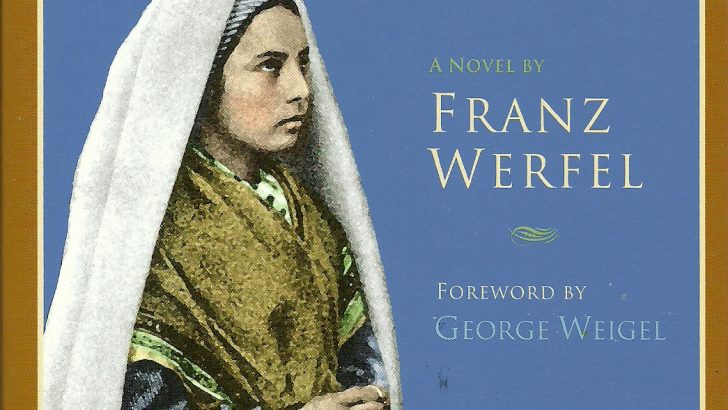Over the 160 years since the world first heard of Bernadette Soubirous’s visionary experiences of the Blessed Virgin Mary in a grotto outside the town of Lourdes much has been has been written about the events of the summer of 1858 by both sceptics and believers.
These events have also, however, given rise to two widely read novels which are both, in their very different way, classics of their kind. These are Emile Zola’s Lourdes (1894), one of a trilogy, and Franz Werfel’s Song of Bernadette (1942).
Zola is one of the leading figures of 19th-Century French literature, a man who is read and written about constantly. He belonged, as he would have admitted himself, to the culture of Catholic France very clearly. The other novelist, Franz Werfel, creator of the Song of Bernadette, was a product of Greater Germany, and its Jewish culture.
Their differing views of Lourdes, of Bernadette and of what occurred in 1858, and what has happened since, make for an interesting comparison of the ways in which the world in general sees Lourdes.
Lourdes is one of the most important sites of pilgrimage on earth. Every year millions go there, most merely to be where something extraordinary once happened, a fewer number go in search of solace or cure. As the turn of the century approached it was one of the most famous places in France.
In the late September of 1891, Emile Zola was on holiday in the Pyrenees with his wife and took the opportunity to visit Lourdes. They spent 15 days in the town and he was so impressed with what he saw then and again in 1892 that it inspired his controversial novel Lourdes.
Successful
This critically successful novel “did more than any other publication to bring the shrine, the cures and the debate over the nature of healing to the wider public”, according to Ruth Harris, writing a century later.
Zola was, like so many today, a positivist with a naturalistic outlook. He did not believe in the possibility of miracles, but he was shaken by Lourdes as a religious and social phenomenon.
Zola saw at once that there would always be controversy about the events surrounding the life of Bernadette – those events were beyond scrutiny, depending on human testimony.
But the alleged miracles were different. In the novel Zola is sceptical about their authenticity, but he centred on a point that is still valid.
Miracles were events, which unlike the apparitions, could be examined and carefully scrutinised. Zola accepted people were “cured”, but like most sceptics saw in this either error in diagnosis or the powers of the body to heal itself.
But in writing the novel Zola could not bring himself to admit that he had, as a matter of fact, witnessed a miracle at the shrine. Asked why he had not incorporated this experience he said he was an artist, not a journalist.
Commonplace
What he meant by this, I think, was that his kind of naturalistic novel dealt with the commonplace and the everyday, what happened in life normally. Miracles were to him as an artist abnormal, and hence could have no place in the normal experience of Lourdes which he wanted to describe.
The experience of Franz Werfel was very different. The Hollywood version of his novel made in 1943 made changes to Werfel’s novel, which in any case was a novel but it arose out of Werfel’s own experiences and personal response to what he saw and heard at Lourdes when he was in flight through Vichy France.
Werfel was born in Prague, the child of a wealthy manufacturing family. However he was greatly influenced by his nurse who often took him to Mass. He was educated at a school run by the Piarist Fathers, as were many wealthy Bohemian Jews. He was a precocious writer, and a friend of Franz Kafka and Max Brod. He moved in the advanced intellectual circles of Central Europe.
In the early ‘30s he travelled widely, experiences from which emerged his novel of the Armenian massacres by the Turks, The Forty Days of Musa Dagh, which was widely read causing great controversy, being especially attacked by the Nazis. With the annexation of Austria, where he then lived, he fled and made his way through France to the US.
His biographer, Peter Jungk, describes how he spent five week in Lourdes, where he was helped by some of the Catholic clergy working at the shrine. He was deeply moved by the stories he heard there of Bernadette, and promised himself “to sing as best he could her song”. He reached New York in October 1940, where he completed the novel his stay in Lourdes had inspired.
The Song of Bernadette was published in May 1942 and became an immense best seller, gaining also critical acclaim. One critic saw it then as “filled with faith in human goodness”. He died in Los Angeles in August 1945, but by that time the novel had become a best seller and had been filmed. It remains in print to this day (Ignatius Press, €19. 95).
It has, I suspect, provided more people both Catholic and non-Catholic with their ideas about the story of Bernadette than any other work of the imagination. Given Werfel’s life and experiences, that in itself is some kind of miracle too.
Werfel stayed close to the actual facts, but his novel is an interpretation by an essential, brave and sensitive man, open to the deep movements of the spirit and of religion in its widest sense. To appreciate the fullness of the Lourdes experience it still deserves to be read.


 Peter Costello
Peter Costello Franz Werfel’s Song of Bernadette
Franz Werfel’s Song of Bernadette 